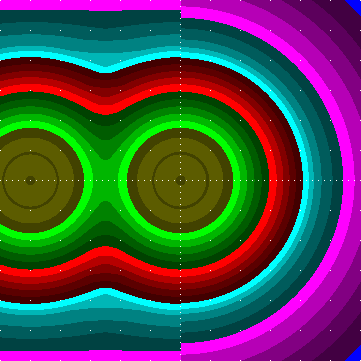



|

|

|
| In left plots, specific illuminances by a continuous row of luminaires spaced 5 and 6 heights are shown in their left halves (right half concerns a single luminaire). | The right plot is for a single luminaire, unrotated. | |

Values below the scale are illuminance / 1 lx. This is for (unrealistic) “unit” case that luminaires would have lamps producing 1 klm only, would be point-like and just 1 m over the terrain.
# IESNA: LM-63-1995
# [TEST] 768841
# [DATE] 12/05/01
# [MANUFAC] COOPER LIGHTING
# [LUMCAT] GFX40SXXAR
# [LUMINAIRE] MEDIUM GALLERIA AREA ROUND
# [LAMP] 400 WATT HPS CLEAR E-18
# [_REFLECTOR] PREMIUM SPUN AREA ROUND
# [_REFRACTOR] FLAT GLASS
# [_SOCKETPOS] FIXED VERTICAL LAMP
# [_LAMPLUMENS] 50000
# TILT=NONE
# Bulbs: 1, 50000 lm each
# Number of measured angles: 37 vertical, 1 horizontal ones
# Photometric type: 1, Units type: 1
# Luminous openig width, length and height: 0.000 0.000 0.000
# Ballast factor: 1, Input power: 400 W
# Source file: gfx4sar.ies
# Luminaire flux = 36403 lm,
# 72.8 % of the bulb flux
# between 75 and 90: 1.3 % of the luminaire flux
# - this part causes just GLARE in case of road lighting and similar purposes
# 80deg and above: max 4.3 cd / 1000 lm , 0.2 % of the luminaire flux
# 90deg and above: max 0.0 cd / 1000 lm , 0.0 % of the luminaire flux
# CutOff Type: Full_CutOff
# 62.5 deg to <67.5 deg: max 234 cd / 1000 lm,
# 67.5 deg to < 76 deg: max 158 cd / 1000 lm,
# maximum spec. lum. intensity 284 cd / 1000 lm
# The following table gives luminous intensities which would be produced
# using a hypothetic bulb giving a luminous flux of 1000 lm (i.e., cd/klm):
0.0 46.3
2.5 45.8
5.0 45.3
7.5 47.8
10.0 53.7
12.5 60.6
15.0 67.8
17.5 75.2
20.0 82.5
22.5 90.4
25.0 97.0
27.5 103
30.0 107
32.5 109
35.0 111
37.5 111
40.0 114
42.5 122
45.0 145
47.5 180
50.0 206
52.5 226
55.0 268
57.5 284
60.0 267
62.5 234
65.0 198
67.5 158
70.0 117
72.5 79.2
75.0 36.5
77.5 10.0
80.0 4.3
82.5 2.0
85.0 0.8
87.5 0.0
90.0 0.0